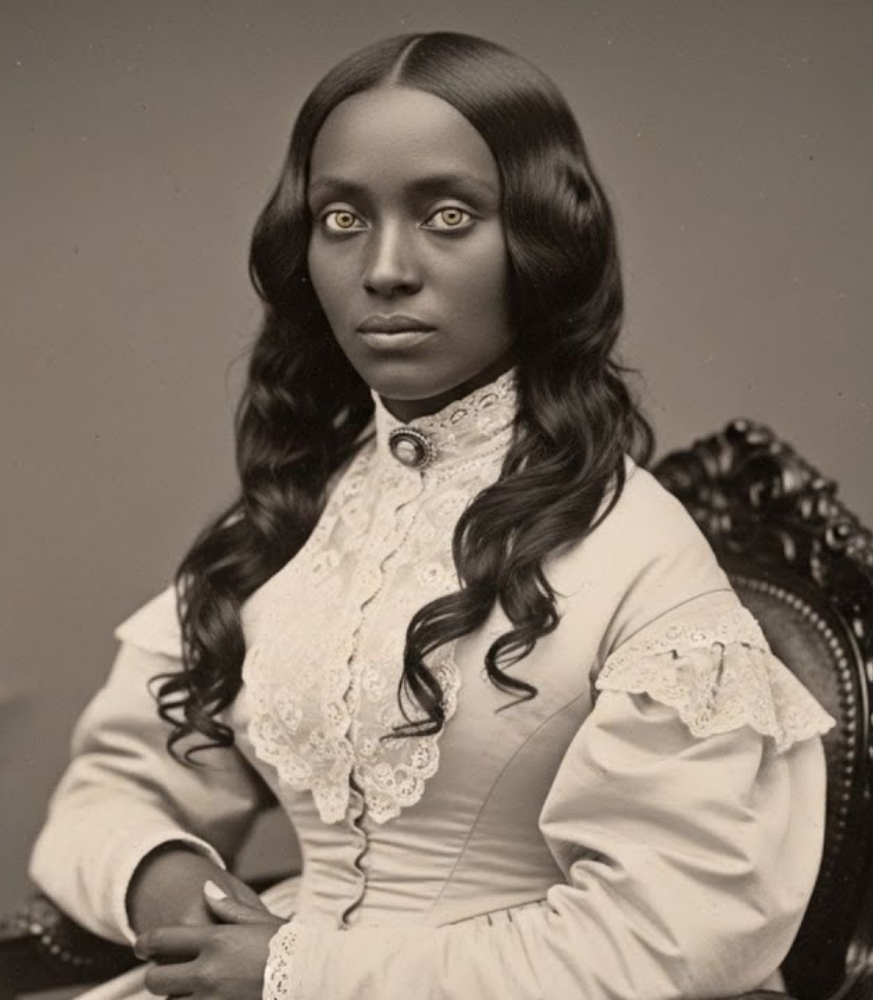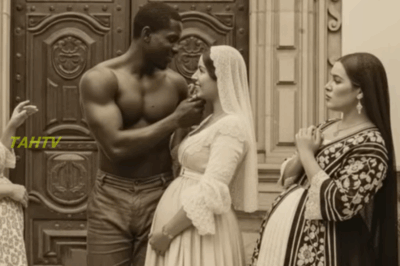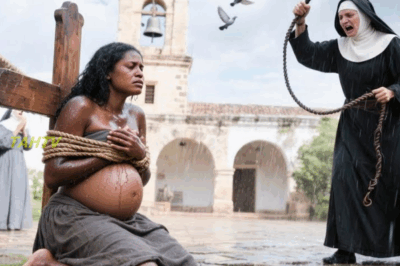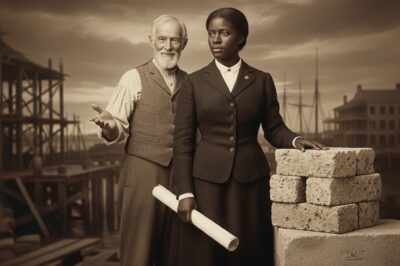The Pearl of New Orleans: An American Mystery
In the autumn of 1837, the St. Louis Hotel in New Orleans shimmered with anticipation. Beneath the gaslit chandeliers, the city’s wealthiest men gathered—not for cotton, nor for sugar, but for a single auction lot. She was known only as “The Pearl,” her beauty whispered about in drawing rooms and alleyways alike. Auction papers described her as five feet four, with skin “the color of fresh cream touched by coffee,” eyes of shifting amber, and hair cascading in glossy black waves.

Her real name was Elellanena Reynolds, but few in the crowd that night knew her history, nor the secrets that would soon unravel across decades and continents.
The auctioneer, Thomas Williams, introduced her as Lot 17. The bidding began at a sum five times that of an ordinary servant. The fever in the room, as recorded by visiting businessman James Thornton, bordered on religious—men driven not by commerce, but by something deeper, more desperate.
What none could have known was that Elellanena had arrived in New Orleans not as cargo, but as a passenger, accompanying a merchant named Marcus Bennett aboard the Augusta. Bennett died en route, leaving Elellanena without free papers—her fate sealed by a technicality. She was seized by port authorities and placed on the block.
The winning bid came from Charles Deloqua, a sugar planter with roots deep in Louisiana’s colonial past. But Deloqua’s purchase was peculiar: he insisted Elellanena be described in the bill of sale not as a slave, but as a “ward,” housed in his Royal Street mansion.
Within those walls, Elellanena’s life became a labyrinth of privilege and captivity. Servants recalled that she was treated as a guest, dressed in fine clothes and given a private room. Yet she was never seen outside, and visitors were told she was a distant cousin from France.
Deloqua’s wife, Isabelle, left for Natchez just weeks after Elellanena’s arrival, taking their children and leaving the mansion shrouded in secrecy. Deloqua conducted his affairs by letter, closing his doors to all but his private secretary.
In January 1838, Dr. Samuel Lawrence was summoned to the house. His medical journal, now preserved at Tulane University, notes Elellanena’s “persistent cough and evident distress.” She spoke of her “true circumstances” before Deloqua returned, ending the conversation.
Rumors swirled through New Orleans society. Some claimed Elellanena was Deloqua’s illegitimate daughter, others his mistress. The most persistent whispers linked her to the Villars family—one of Louisiana’s oldest, wealthiest, and most secretive lineages. Henri Villars, the family patriarch, had been among the aggressive bidders at the auction.
The connection between Elellanena and the Villars family remained a mystery until renovations at the Deloqua mansion in 1962 uncovered a hidden room: inside, a leather-bound journal, three human fingerbones, and a portrait of a woman whose beauty seemed almost supernatural.
The journal, written in Elellanena’s hand, revealed her life in captivity. She described reading in the family library, forbidden from leaving the courtyard “for her protection.” She suspected her legal status—without free papers—was being used to keep her compliant.
By summer, Elellanena plotted escape. She contacted a housemaid to deliver a message to the American consul, hoping her birth in Philadelphia would establish her freedom. But the maid betrayed her. “It was a trap,” she wrote. “I am to be moved tomorrow.”
She was sent to Bow Refuge, Deloqua’s sugar plantation, kept in the overseer’s house, isolated from both the family and the slaves. There, she met Joseph Miller, a northern abolitionist posing as a doctor. Miller’s coded correspondence, later published, described a “woman of unusual circumstance” held at Bow Refuge, claiming to be born free in Philadelphia to a free mother.
Miller promised to help, but fled Louisiana when his true identity was discovered. Elellanena’s journal grew sparse, her hopes fading.
In February 1839, Henri Villars visited Bow Refuge. He asked about a gold locket Elellanena’s mother had worn—engraved with a ship. He confirmed something, perhaps her parentage, before leaving, promising to return. Three days later, Henri died, triggering a legal battle over the Villars estate.
Elellanena’s entries grew frantic. Deloqua searched her room, confiscated her mother’s Bible and birth certificate—the only proof of her identity. She realized the truth: she was not being held for her value as property, but to prevent her from claiming the Villars inheritance. If she could prove her father was Jean Baptiste Villars, Henri’s disinherited son, she would have a claim under Louisiana’s unique legal code—a claim that would scandalize the city.
In September 1839, Elellanena escaped Bow Refuge with Martha’s help, trading pearl earrings for passage on a riverboat. Records show a woman matching her description vanished from the plantation that night. Evidence suggests she returned to New Orleans, perhaps seeking her mother’s papers.
A receipt from a French Quarter apothecary, charged to Marie Laveau—the famed voodoo priestess—suggests Elellanena found shelter among Laveau’s network. For three years, she vanished from all records.
In 1842, Elellanena reappeared at the Mardi Gras Ball, elegantly dressed on the arm of Louis Villars, Henri’s nephew and the new family heir. The city buzzed with rumor. Had Louis purchased her freedom? Had she discovered documents proving her claim?
Charles Deloqua, also at the ball, became visibly agitated, attempting to confront Elellanena and Louis before being restrained. Days later, he filed a legal complaint—quickly withdrawn. On February 12, Elellanena and Louis boarded a steamship for France, traveling as “Mr. Louis Vars and Ward.” They never returned.
Two weeks later, the Deloqua mansion stood empty. Servants had packed trunks; the family vanished. Bodies of Deloqua’s secretary and plantation manager were found in the swamps—execution-style. The investigation yielded nothing; witnesses refused to speak.
For a century, the disappearance haunted New Orleans. In 1962, Elellanena’s journal, fingerbones, and portrait surfaced in the hidden room. Forensic analysis suggested the bones belonged to a male, possibly Deloqua. The portrait, when x-rayed, revealed another image beneath—a family portrait of Jean Baptiste Villars, his wife, and infant daughter.
Letters discovered in 1982, exchanged between Louis Villars and a Paris correspondent, suggested a private settlement: Elellanena received freedom and financial compensation in exchange for silence. Deloqua, excluded, posed a threat. In 1994, a confession signed by Louis Villars was found in the Villars estate, admitting to arranging the elimination of Charles and Isabelle Deloqua, and sending their children to Cuba under Martha’s care.
DNA testing in 2002 confirmed a biological link between Elellanena and the fingerbones—likely Deloqua’s—found in the mansion.
Elellanena lived out her days in London, dying at 55, surrounded by family. Her children married into English society, her story forgotten until rediscovered by historians.
The Deloqua children vanished into history. Records from Cuba showed no further trace. In 1981, a flatboat containing four bodies—matching the Deloqua family and associates—was found in the Mississippi, confirming a violent end.
Today, Elellanena’s portrait hangs in the museum, her journal an eloquent testament to resilience. The mansion operates as a historic hotel, its hidden room preserved. Guests report footsteps, laughter, and a sense of being watched.
The story of The Pearl is not just about beauty or suffering, but determination—the refusal to accept the fate others imposed. It is a story of a woman who wrote herself into being, transcending the boundaries of race, law, and history.
As night falls over the French Quarter, the secrets of Elellanena Reynolds linger in the warm southern air—a reminder that the past is never truly past, and that the human spirit, once awakened, cannot be contained.
News
Esclavo Embarazó a Marquesa y sus 3 Hijas | Escándalo Lima 1803 😱
En el año 1803 en el corazón de Lima, la ciudad más importante de toda la América española, sucedió algo…
“Estoy perdida, señor…” — pero el hacendado dijo: “No más… desde hoy vienes conmigo!”
Un saludo muy cálido a todos ustedes, querida audiencia, que nos acompañan una vez más en Crónicas del Corazón. Gracias…
La Monja que AZOTÓ a una esclava embarazada… y el niño nació con su mismo rostro, Cuzco 1749
Dicen que en el convento de Santa Catalina las campanas sonaban solas cuando caía la lluvia. Algunos lo tomaban por…
El año era 1878 en la ciudad costera de Nueva Orleans, trece años después del fin oficial de la guerra, pero para Elara, el fin de la esclavitud era un concepto tan frágil como el yeso
El año era 1878 en la ciudad costera de Nueva Orleans, trece años después del fin oficial de la guerra,…
“¡Por favor, cásese con mi mamá!” — La niña llorando suplica al CEO frío… y él queda impactado.
Madrid, Paseo de la Castellana. Sábado por la tarde, la 1:30 horas. El tráfico mezcla sus ruidos con el murmullo…
Tuvo 30 Segundos para Elegir Entre que su Hijo y un Niño Apache. Lo que Sucedió Unió a dos Razas…
tuvo 30 segundos para elegir entre que su propio hijo y un niño apache se ahogaran. Lo que sucedió después…
End of content
No more pages to load












